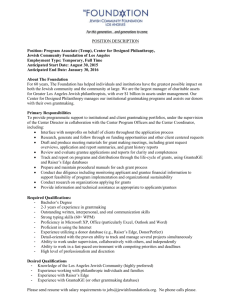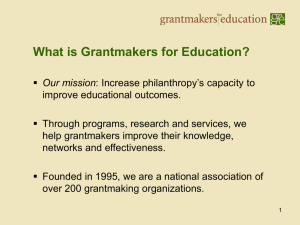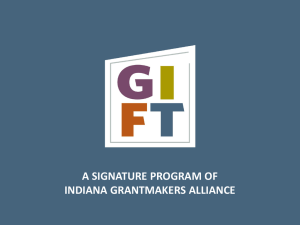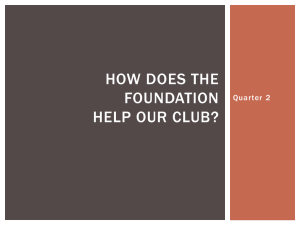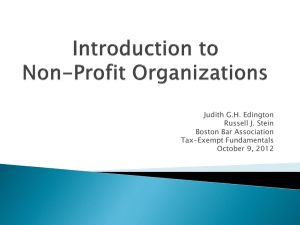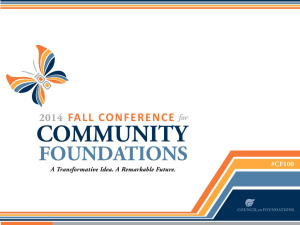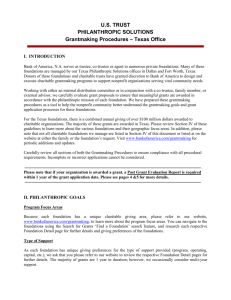Grantmaking & Community Leadership
advertisement
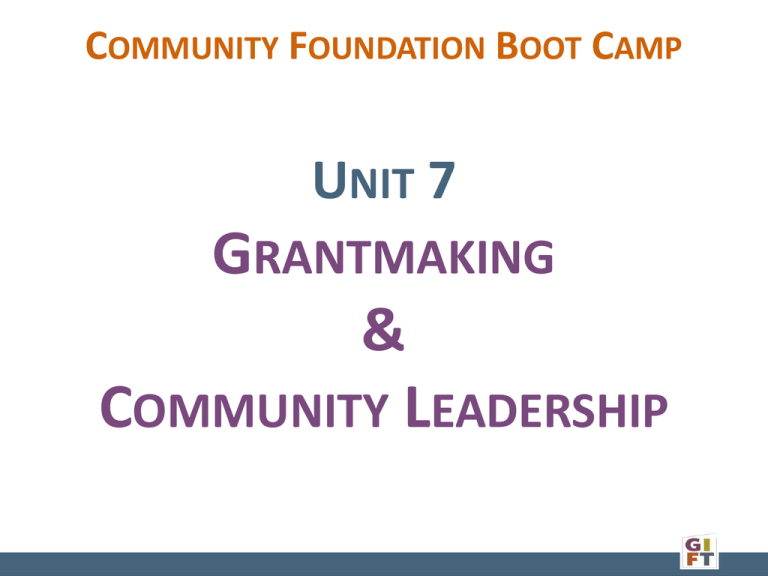
COMMUNITY FOUNDATION BOOT CAMP UNIT 7 GRANTMAKING & COMMUNITY LEADERSHIP GRANTMAKING A distribution from any type of fund for a charitable purpose is a “grant” Generally, a community foundation uses the term “grantmaking” to refer the process of deciding on distributions from the unrestricted funds and field-ofinterest funds Usually, this a fairly open, competitive process The IRS “5%” rule doesn’t apply to community foundations; only private foundations GRANTMAKING There are two primary types of grantmaking Responsive grantmaking • Community foundation “responds” to community requests • Open process, broad criteria Proactive/strategic grantmaking • Community foundation decides in advance the type of grants it wishes to make; narrow criteria • Typically uses an RFP or other invitation STRATEGIC GRANTMAKING Can require more staff time than responsive grantmaking Difficult to be strategic with small amounts of money Can create a very positive internal discussion around the role of the community foundation Not always perceived positively as some see it as “taking funding away” from other needs GRANT PROGRAM GOALS (YOU HAVE TO CHOOSE) Think about what you want to achieve with your grant dollars before the proposals come in Talk about the nonprofits in your community, their role, impact and their challenges Are you interested in supporting: • Programs for particular populations? - youth, seniors • Particular sectors? – basic needs, education, arts Think about how the funds you have can make the most difference TYPES OF GRANTS Operating – grant for general operations of a nonprofit Program support – to fund an existing program or start a new one Capital – structures, furnishings or equipment Capacity-building – to improve the functioning of a nonprofit Planning grant Program-related investment – using investment dollars to provide value to your community GRANTMAKING PROCESSES Establish criteria and priorities Balance priorities against available resources Number of cycles; timetable Design orientation and training for grant committee members Create structure for review process Letter of inquiry first or just proposal? Site visits; document charitable status; other review process Same process for all or vary by grant size? Establish reporting requirements Grant guidelines and materials–should be publicly available RESPECT YOUR APPLICANTS AND GRANTEES They are the ultimate reason we exist Understand the power differential Try to understand the reality of their world Keep your proposal and reporting in balance with the resources you provide Communicate in a timely fashion PENSION PROTECTION ACT OF 2006 (PPA) Why? Senate Finance Committee concerned about abuses in the charitable sector including: • Abuse of donor advised funds • Control by donors over scholarships • Personal benefit by donors What? Defined Donor Advised Funds (“DAFs”) for the first time Distinguished DAFs from “single” advised funds and scholarships with donor advising Delineated key aspects of due diligence for expenditure responsibility Created the IRA Charitable Rollover WHAT IS EXPENDITURE RESPONSIBILITY? Reasonable and prudent due diligence to confirm that a grant is used for qualified charitable organization, purposes and/or programs. Two ways of exercising expenditure responsibility are: 1. Documenting that you are granting to a charitable entity, that is, a 501(c)(3)/509(a) 2. Taking on additional documentation and reporting requirements when you grant to a non-charitable organization for charitable purposes. This is typically called “taking expenditure responsibility.” WHEN IS “TAKING ER” REQUIRED? Grants to any organization not qualified per 501(c)(3) Grants to individuals (Scholarships/Disaster Relief/Good Samaritan) • Criteria/Broad charitable class • Screening process Five Steps 1. Pre-grant inquiry 2. Written agreement 3. Separate account 4. Regular reports 5. 990 reporting (Use schedule O to explain details) SCHOLARSHIP FUNDS Pension Protection Act created many new requirements for the administration of scholarship funds Most particularly, donor may not control the distribution of scholarships For more information, contact the GIFT office or access recorded webinar on the PPA COMMUNITY PROJECT FUNDS A group of individuals determine a solution to a community need (grassroots project) The group does not have 501 (c)(3) status They want to use the community foundation as an umbrella for donors to make charitable gifts Fund agreement required, stating charitable purpose or program Can be a one-time project or a new program Grants made to vendors for specific charitable purpose or program Determine liability issues Expenditure responsibility required Community foundation is operating the program directly FISCAL SPONSORSHIP: ACCEPTABLE An organization determines a solution to a community need (grassroots project) The group does not have 501 (c)(3) status, could be a mutual benefit organization, etc. They want to use the community foundation as an umbrella for donors to make charitable gifts Fund agreement required, stating charitable purpose or program Can be a one-time project or a new program Grants are to the non-charitable organization for the charitable purpose or program Determine liability issues Expenditure responsibility required CHALLENGING ACTIVITIES During the early years a community foundation tends to say “yes” to everything HOWEVER All these activities come with a huge workload driving up expenses Community foundation should have policy on what to allow Community foundation should consider the fee structure they will charge Community foundation should consider “opportunity cost” COMMUNITY LEADERSHIP Community foundations have knowledge, connections, influence and resources that can be used to for positive change in a community Every community must assess its capacity for leadership before jumping into this role. Values, culture and will Relationships Resources Understanding and skills LEVELS OF COMMUNITY LEADERSHIP Levels of community leadership listed in order of increasing complexity/risk: 1. 2. 3. 4. 5. 6. Community engagement Bridge for communication Provide a product or service Proactive grantmaking Community convener Community initiative COMMUNITY ENGAGEMENT Example Participating in community activities and organized by other groups or institutions Sponsor a community event or activity Considerations Easy to do Everybody wants the CF “at the table” so be cautious about overextending Good way to learn about community, forge relationships BRIDGE FOR COMMUNICATION Example Bring together a few grantees with similar missions to create relationships Considerations Fairly easy to do; not much risk Do a little background work to make sure you are not walking into some bad history PROVIDE A PRODUCT OR SERVICE Examples Provide training or other capacity-building opportunity for not-for-profits Host a speaker on philanthropy or more specific topic Considerations Involves additional cost and staff time More public visibility Not much risk PROACTIVE/STRATEGIC GRANTMAKING Example Allocate a portion of unrestricted grantmaking to a particular area, need or opportunity Considerations Constructing the “strategy” and defining intended results can be positive by time-consuming Moves into a more political arena both internally an externally COMMUNITY CONVENER Example Organize a community meeting to discuss an issue or opportunity Considerations Much more public Needs considerable preparation to go well CF will be perceived as having some ability to follow through on whatever happens Think about the end game COMMUNITY INITIATIVE Examples CF declares it will address a particular issue Considerations Enables CF to engage broadly and demonstrate a major “value add” to the community Requires significant investment of time and money for which there is likely no revenue stream Very public; CF reputation can suffer if problem is not “solved” Possible donor alienation Possible political controversy
